
VOGUE: Still Spreading Western Beauty Ideals?
Vogue Magazine has had a history of spreading Western beauty standards across the world through their magazine covers. But is the global magazine still doing this in 2018? This article delves into the phenomena of globalization and the westernization of global beauty ideals. I will also take a look at diversity in Vogue in 2018 as compared to the past.
Vogue and the importance of fashion magazines
Vogue is a worldwide fashion and lifestyle company owned by Condé Nast. Vogue Magazine is very influential not only in the United States, where it was founded in 1892, but all over the world. Vogue Magazine has a total circulation of 1,231,650 (Consumer Magazines, 2019) and has around 21 million followers on their main Instagram account.
The magazine currently has 23 international editions, each with their own monthly publications (“Vogue (magazine)”, n.d.), and they continue to expand. They launched Vogue Polska (Poland) and Vogue CS (Czech Republic & Slovakia) in 2018. In 2019 they will be launching Vogue Hong Kong, and there are speculations about Vogue Africa coming in the future.
Besides offering brand advertisements and information about the industry, these fashion magazines reflect culture and beauty standards, both visually and textually. They give us insight into what the dominant cultural trends are regarding fashion, beauty, and lifestyle (Kopnina, 2007).
Magazines are the voice of the fashion world.
Vogue Magazine features primarily female models and celebrities on their covers. These covers are the result of careful judgement and selection by editors. Theyare socially meaningful because the presented models or celebrities reflect the beauty ideals of the magazine and current times (Han & Rudd, 2014). TCover pages are the first thing people see, and they are designed to have a big impact in order to draw in readers. Even those who do not read fashion magazines are still exposed to magazine covers through multiple media sources.
Globalization and homogenization
It is a truism that we live in a time of globalization. A time where transnational scapes create a convergence in global culture. Fashion magazines, as a part of the mediascape, are no exception. Globalization changes the dynamics between global and local culture. Specific regional cultures are influenced and changed by the global culture, and they start to all have similar features. There is at least a partial emergent homogenization of different cultures (Appadurai, 1996).
Globalization is changing local cultures and integrating them into a universal standard of beauty.
This includes beauty ideals and standards. Before this period of globalization every 'culture' had their own beauty and attractiveness standards that originated from their traditional views on beauty and the physical appearances of their people. However, globalization is changing local cultures and integrating them into a universal standard of beauty.
Such worldwide beauty standards are to a large extent still dictated by western ideals. Western ideals include features such as round eyes, thin body, light skin, narrow faces, small noses, high cheekbones, etc. These western ideals are integrated into national beauty and attractiveness standards of many different countries such as Brazil, Saudi Arabia and Japan, even though the women of these countries often look nothing like the ideal western woman (Yan & Bissell, 2014).
Vogue in recent years
Two studies published in 2014 found that Vogue Magazine contributed to the westernization of the global culture regarding beauty ideals and attractiveness standards.
A study by Yan and Bissell (2014) found that fashion magazines, including Vogue, had a preference for western ideals over local models. This was especially clear in parts of the world such as Asia and Latin America, however the same counted for Europe. European editions might have had both local and international models featured. However, the international models were mainly from the UK and the US who still fit western beauty standards.
The study further found that local models had a hard time getting into their own local editions of the magazine: they had one-third of the space and the rest were western models/celebrities. Local models also had no chance of getting into western editions such as the UK or US versions of magazines. It was clear that fashion magazines did not see non-western models as fitting their beauty ideals.
A study by Han and Rudd (2014) had similar findings. In the four editions of Vogue that they analyzed, they found that more than 70% of the magazine covers featured western models.
However, in December of 2015 Vogue took a stance on diversity and announced their intention to increase the diversity of their model choices. This was the first time Vogue had outright addressed the topic of diversity in relation to their magazine. In 2017 Edward Enninful was appointed as the new editor in chief of British Vogue. As he is known for bringing diversity into magazines, people hoped Enninful would not only bring diversity into British Vogue but also inspire other editions of Vogue to do the same. Edward Enninful himself said:
“My Vogue is about being inclusive, it’s about diversity. Showing different women, different body shapes, different races, class.” (BBC interview Edward Enninful)

American Vogue March 2017 Issue
The title of American Vogue’s March 2017 issue was "No Norm Is The New Norm". This issue was an attempt at diversity but received criticism because the cover only featured one plus size model (who was covering up her thigh with her hand). It also received criticism for including Kendall Jenner and Gigi Hadid, who had already been featured in countless other issues of Vogue Magazine. It seems Vogue has been trying to move towards the ideal of more diversity but has not been completely successful yet. So the question is, have they have improved their attempts at inclusivity and diversity in 2018?
Vogue in 2018
I have taken a look at five Vogue Magazine editions and their issues from 2018. I randomly chose to do a short analysis of British Vogue, Vogue Japan, Vogue Россия (Russia), Vogue Brasil and Vogue Arabia. While analysing the issues I took a look at the nationality, body type, and skin complexion of the cover models.
British Vogue
Out of the 29 cover models featured on 2018’s issues, only 8 were not British, American or Australian. Out of the 12 issues, 5 of them feature non-white women. These include Gugu Mbatha-Raw (April), Oprah Winfrey (August), Rihanna (September), and Adut Akech (December). There was one cover that stood out, as the May issue featured nine different models from across the world that all look very different from one another in many respects.
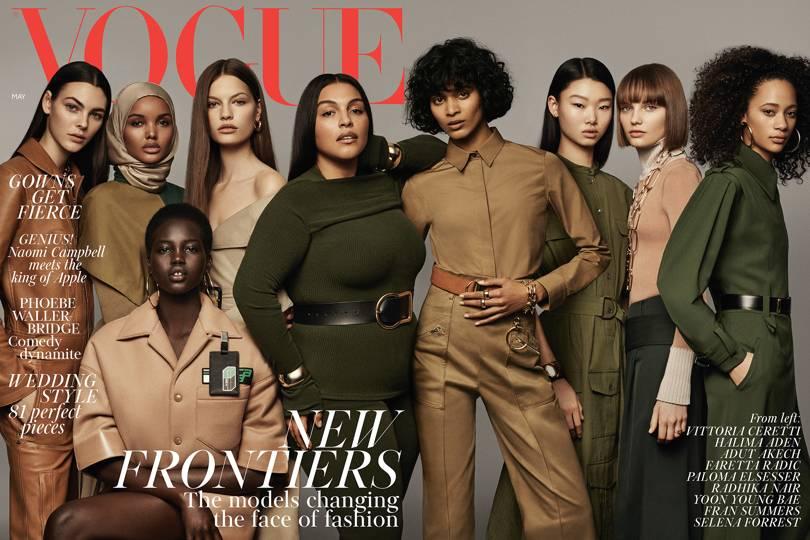
British Vogue May 2018 Issue
When taking a brief look at the covers of earlier years, you can see that changes have been happening in 2018 for British Vogue. There definitely has been an increase in diversity, and evidently it seems like Edward Enninful stayed true to the words he said back in 2017.
Vogue Japan
Vogue's Japan edition features 18 models total on their 2018 covers. Ten of these are American, 5 from Europe, 2 from Latin America and only 1 from Japan. The only 2018 issue featuring a Japanese cover model appeared in October. The fact that Vogue Japan only featured one Japanese cover model in all of 2018 is quite telling.
The majority of the cover models fit the western beauty ideals, ideals that are very different from Japanese women, and Japanese women are the ones who read Vogue Japan. Local Japanese models have practically no chance of being on the cover, and Japanese women in general get little to no representation in their own version of Vogue. Besides very little diversity of nationalities, there is also no diversity in the body types presented, as all the cover models are thin.
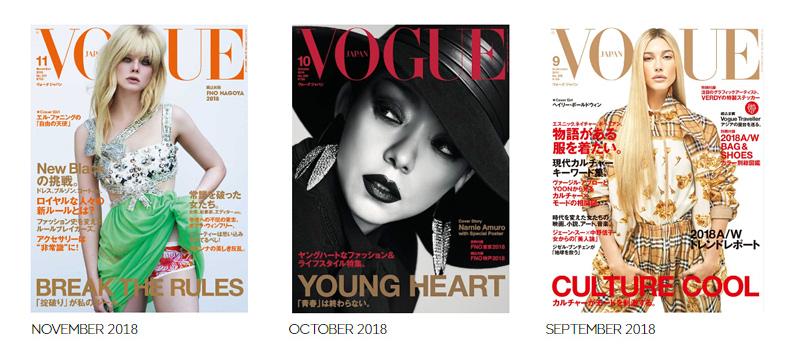
Vogue Japan 2018 Issues
Vogue Россия
Russia’s choice of cover models is quite interesting. Seven out of the 14 female cover models are Russian. From the remaining models 2 of them are American and 5 are European models. This means local Russian models do get a chance to be on Vogue Russia, and Russian women are represented. All the female cover models however fit the western beauty ideal of having thin bodies, light skin, round eyes, etc. The diversity in the appearance of the models is extremely low.
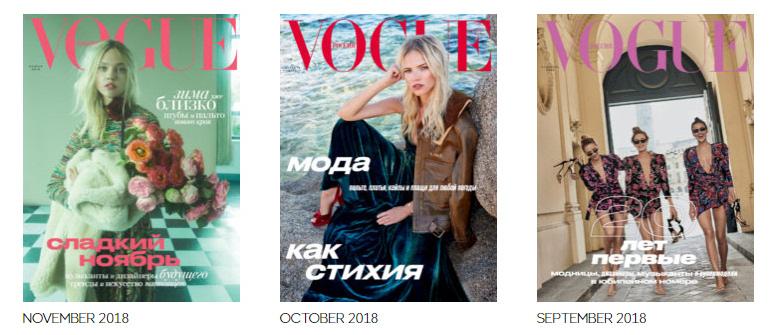
Vogue Russia 2018 Issues
Vogue Brasil
Vogue Brasil showcased diversity in their model choices in regards to skin complexion and facial features. They featured primarily Brazilian models in 2018. Out of the 17 cover models 2 were African, 3 were American, 1 was Dutch and the rest were Brazilian. However, they show no diversity when it comes to body types - all the models are thin.
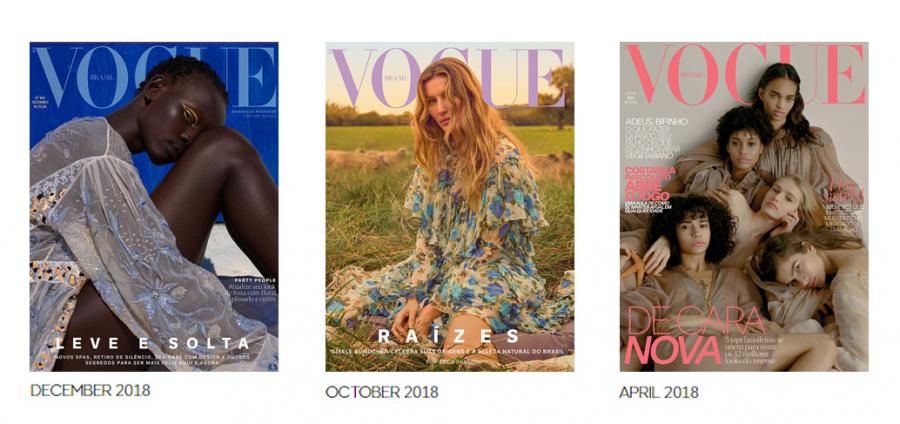
Vogue Brasil 2018 Issues
Vogue Arabia
Vogue Arabia primarily featured models from countries in North Africa and West Asia. Nine out of the 17 models are from countries such as Lebanon, Algeria, Kuwait, Jordan, Egypt and Saudi Arabia. The other featured models are from America, United Kingdom, The Netherlands, Russia and Canada. There is quite a bit of variety in skin complexion being presented as well as facial features. Most models are thin, but the July/August issue jumps out because it features two plus size models (Paloma Elsesser and Ashley Graham).
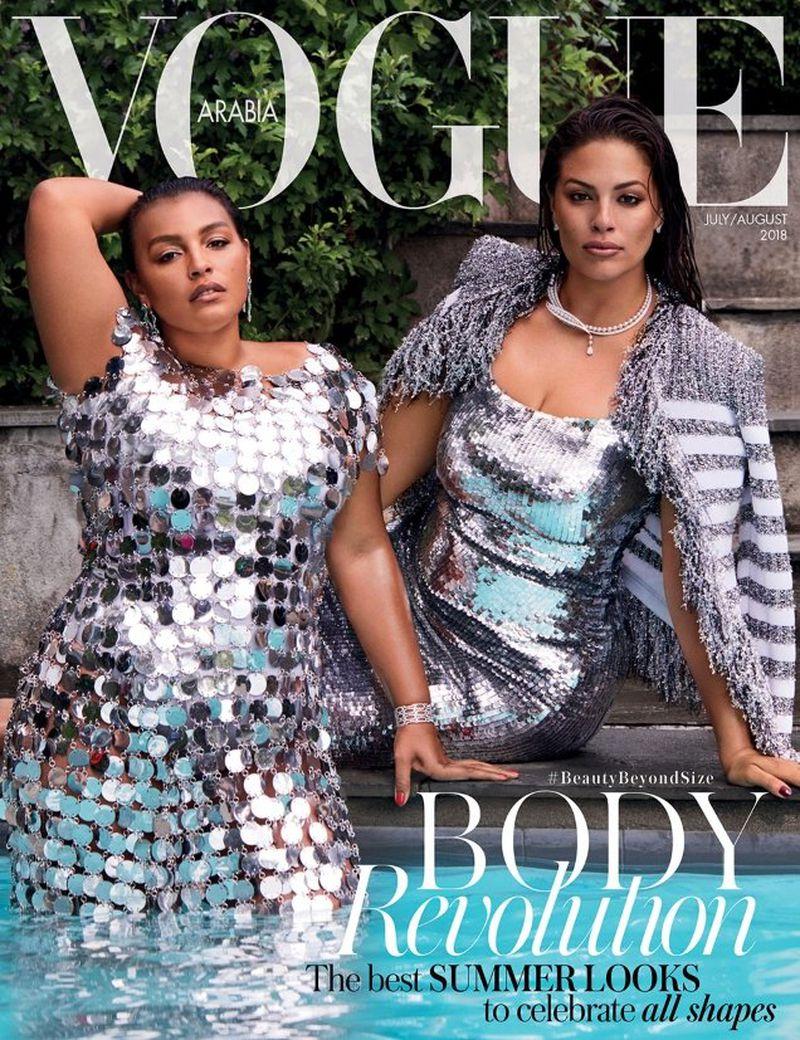
Vogue Arabia July/August 2018 Issue
Diversity according to Vogue
Vogue Japan seems to cater to western beauty ideals the most out of the five analyzed editions. Vogue Russia also has very little diversity in their cover models, but at least they feature models from their own country. What is surprising to see is that little to no Asian models are featured in the Vogue Magazine editions, with the exception of Vogue Arabia (who only feature models from West Asia).
Vogue’s editions differ a lot from one another in regards to diversity, with some editions including more diversity than others. It seems that diversity in nationality and skin complexion is much bigger than diversity in body types. A very small amount of issues featured models that were not thin. The only issue that featured only plus size models is the July/August Vogue Arabia issue. Overall it seems Vogue has taken a small step towards more diversity in cover models, however, not all editions are as diverse as others and the number of Asian models presented is scarce.
It is great to see that Vogue is including more diversity in their cover models. Diversity in media like fashion magazines is extremely important. Shining a positive light on people with different ethnicities or body types, as well as minorities and disadvantaged groups, helps overthrowstereotypes that are embedded in our society (Evgenivna, 2017). Repeated exposure to diversity is essential to change internalized social attitudes we have toward physical appearances. Representation of different types of people in the media shows us, especially younger generations, that it is normal to be different from one another. It shows that people from all around the world are included and celebrated as beautiful.
In previous years Vogue Magazine has contributed to the domination of global beauty culture by western ideals. However, it seems Vogue is now slowly but surely taking a different path. They are including more local cultures in their magazines, which counteracts the homogenization of the mediascape that came about with globalization. Vogue is following the the trend of “orchestrated” diversity as described by Jones (2011) in his paper “Globalization and Beauty: A Historical and Firm Perspective”. This is because consumers demand a mix of the global and the local when buying brands and consuming media. Jones (2011) states:
“If Henry Kissinger was right that globalization in the past was another name for Americanization, or at least Westernization, this is not the case now. In beauty as in many other things, globalization is no longer a one-way street. Beauty is at the epicenter of the contradictions in today’s world, which is simultaneously growing evermore flat, and evermore spiky, as the local re-asserts itself.” (Jones, 2011, p. 911)
This perfectly describes what is currently happening within the beauty and fashion industry, including Vogue Magazine.
In beauty, as in many other things, globalization is no longer a one-way street.
In the international 2018 editions of Vogue examined in this article, not all were equally progressing towards more diversity, but overall it seems Vogue is heading in the direction of more inclusivity and diversity on their magazine covers. Vogue is broadening their definition of beauty and giving women around the world more representation. Let's have another look at Vogue Magazine's development at the end of 2019.
References
Appadurai, A. (1996). Modernity al large: cultural dimensions of globalization. Minneapolis, London: University of Minnesota Press.
Consumer Magazines (2019). Alliance for Audited Media. Retrieved January 3, 2019.
Evgenivna, D. (2017). The Power of Diversity in the Media.
Han, T., & Rudd, N. A. (2015). Images of beauty: Sex, race, age, and occupational analysis of fashion magazine covers. Journal of Global Fashion Marketing, 6(1), 47-59. doi: 10.1080/20932685.2014.926131
Jones, G. (2011). Globalization and Beauty: A Historical and Firm Perspective. EurAmerica, 41(4), 885-916. doi: 10.4337/9781782548188.00009
Kopnina, H. (2007). The World According to Vogue: The Role of Culture(s) in International Fashion Magazines. Dialectical Anthropology, 31(4), 363–381. doi: 10.1007/s10624-007-9030-9
Vogue (magazine) (n.d.). In Wikipedia, The Free Encyclopedia. Retrieved January 3, 2019.
Yan, Y., & Bissell, K. (2014). The Globalization of Beauty: How is Ideal Beauty Influenced by Globally Published Fashion and Beauty Magazines?. Journal of Intercultural Communication Research, 43(3), 194-214. doi: 10.1080/17475759.2014.917432